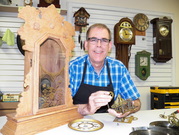|
I have had several customers ask me this. Sometimes they have been told by “clockmakers” that adding bushings will devalue the clock. These same “clockmakers” then proceed to take a prick punch and scar up the movement with abandon. What is the truth about bushings? A clock in mint condition is always more valuable that a clock in excellent condition. That is because mint means it is in the exact condition it was when it was made, or “new and in the box.” Mint condition clocks are more valuable because they are so rare. A mint condition clock will have no wear, so it will have no need for bushings. Adding bushings to a mint condition clock would decrease the value of the clock because the clock would no longer be in the condition it was in when it was made. Most antique clocks have been used, but they may still be in very good condition. However after 100, 200, or 300 years of use, some wear is bound to occur. Repairs are expected, and well done repairs do not detract from the value of the clock. Bushings are recognized by the American Watchmakers-Clockmakers Institute as the best method for correcting worn pivot holes. Pivot holes wear because a clock needs oil for the gears to turn freely, but the oil will trap dust from the air. The dust accumulates in the oil and acts as a grinding compound. Eventually, the pivot hole becomes worn on the side of the hole that the pivot presses against. As the hole becomes more oblong the gear slips out of alignment with the other gears. The teeth don’t mesh properly, and friction increases until the clock stops.
To correct worn pivot holes the American Watchmakers – Clockmakers institute recommends installing a bushing (a brass or bronze cylinder with a hole in the center resembling a bead). The original hole is opened up. Care must be taken to keep the larger hole centered on the original pivot hole. Then a bushing is pressed into the hole. The alternatives to installing bushings are as follows:
Properly installed bushings will return gears to their proper alignment and will provide the optimal bearing surface for the pivot. Carefully and accurately installed bushings will enhance the performance of the clock and result in increased value of the clock.
4 Comments
3/29/2019 01:38:49 pm
I was thinking about getting a clock repair service. It might be useful for me to know a little more about how to make sure that it is kept up. Getting ball bearings in your clock is a great idea.
Reply
6/24/2019 01:51:33 pm
I had no idea that badly installed bushings in a clock can be such a huge issue! I think it would be a good idea for me to take my grandfather clock into a repair shop to have them install the bushings properly. This way the gears will align better and the value of my clock will increase as well, making it a worthwhile repair.
Reply
7/2/2019 10:56:34 pm
Bushings require a lot of work to install properly. There are lots of hobbists that can do a very good job of installing bushings, but you do want to be careful about who you let work on your clock. It is possible to make things worse instead of better.
Reply
10/7/2020 09:31:50 am
Thanks for the tip to install ball bearings in a clock to reduce friction. I want make sure that my clock doesn't lose too much value. It would be nice to have it restored as much as possible even that means adding in new pieces.
Reply
Leave a Reply. |
Mike SarchetI am passionate about restoring and repairing antique clocks. In this blog I answer commonly asked questions about how to care for your clock. Frequently Asked Questions:
|
|
Email: mike@wiseowlclock
repair.com |
|


